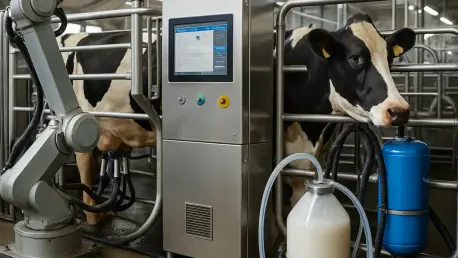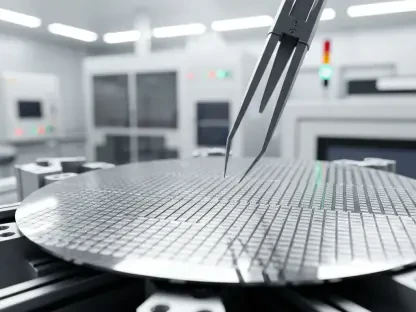In an era where technology is reshaping industries at an unprecedented pace, Fonterra, a global dairy cooperative with over a century of expertise, stands at the forefront of innovation by integrating Artificial Intelligence (AI) and automation into its operations to redefine efficiency. This strategic embrace of cutting-edge tools is not merely a response to industry trends but a bold redefinition of how dairy processing can achieve unparalleled efficiency, sustainability, and quality. From the meticulous inspection of milk powder bags to the seamless movement of goods across factory floors, Fonterra is harnessing these advancements to address critical challenges like waste reduction and operational scalability. The impact of this transformation ripples through every facet of the business, setting a benchmark for competitors and promising enhanced value for farmers and customers alike. As the dairy sector navigates a competitive and dynamic market, Fonterra’s commitment to technological progress offers a glimpse into the future of food production.
Elevating Standards through AI in Quality Control
Fonterra’s adoption of AI-driven image recognition technology marks a significant leap in quality assurance, particularly in the inspection of millions of milk powder bags produced annually. Developed by in-house experts, this sophisticated system meticulously scans for defects across numerous bagging lines, automatically rejecting substandard products while capturing timestamped images for traceability. The result is a dramatic reduction in waste and downtime, ensuring that only top-tier products reach the market. This technology not only upholds stringent quality standards but also minimizes the need for manual checks, allowing staff to focus on more complex tasks. Its implementation showcases how AI can transform routine processes into highly efficient, reliable operations, reinforcing consumer trust in the brand’s commitment to excellence.
Beyond milk powder, this innovative approach extends to butter packaging at key facilities, where AI monitors multiple production stages with precision. If a fault is detected, the system halts operations instantly, alerting operators to intervene before issues escalate. This proactive mechanism ensures consistent product quality while reducing the risk of costly errors or recalls. Unlike traditional methods that rely heavily on human oversight, this AI integration offers a level of accuracy and speed that manual processes simply cannot match. By embedding such technology into critical areas, Fonterra demonstrates a forward-thinking mindset, prioritizing both efficiency and reliability in delivering dairy products that meet global standards.
Boosting Efficiency with Automated Operations
Automation has become a cornerstone of Fonterra’s strategy to streamline packing and palletizing, enabling round-the-clock operations with minimal human intervention. Custom-designed Automated Guided Vehicles (AGVs) are central to this shift, efficiently managing tasks like loading empty pallets, moving finished goods, and ensuring smooth transitions across production areas. These driverless forklifts, combined with robotic systems for filling, sealing, and stacking, create a seamless workflow that maximizes throughput. The reduction in manual labor not only cuts operational costs but also mitigates human error, ensuring consistency in high-volume environments. This level of automation reflects a deliberate push toward operational excellence in an industry where timing and precision are paramount.
The benefits of such automated systems extend beyond mere productivity gains, as they also enhance workplace safety and resource allocation. With machines handling repetitive and physically demanding tasks, employees are freed up to tackle roles that require critical thinking and problem-solving. This shift fosters a more dynamic work environment while ensuring that production lines operate without unnecessary interruptions. Additionally, the integration of machine learning into inspection processes during palletizing guarantees that every product meets exacting standards before shipment. Fonterra’s investment in these technologies underscores a broader vision of creating resilient, scalable operations capable of adapting to fluctuating market demands.
Optimizing Resources with AI-Powered Scheduling
Fonterra’s innovative approach to operational planning is evident in the deployment of the Plant Equipment Scheduling Program (ESP), a tool that leverages AI to revolutionize traditional methods. By replacing outdated spreadsheets with a centralized system that integrates real-time data, ESP optimizes maintenance schedules, resource allocation, and production timelines based on site-specific constraints. This data-driven solution ensures that processing capacity, energy usage, and buffer management are balanced effectively, minimizing disruptions. Successfully piloted at select locations, the program has already shown promising results in improving coordination, paving the way for broader adoption across facilities. Such advancements highlight how AI can transform back-end processes into strategic assets.
Further enhancements to ESP are on the horizon, with plans to incorporate network-wide optimization and real-time scenario modeling. These upgrades aim to provide even greater flexibility in responding to unexpected challenges, such as equipment failures or sudden shifts in demand. The positive feedback from operational teams using the system indicates strong acceptance and potential for continuous improvement. Unlike manual scheduling, which often struggles with complexity and delays, this AI-driven tool enables faster, more informed decision-making. Fonterra’s focus on smarter planning through technology not only boosts efficiency but also sets a precedent for how data can be harnessed to drive long-term operational success in the dairy sector.
Strengthening the Supply Chain with Data Insights
AI’s transformative power at Fonterra extends far beyond individual processes, permeating the entire supply chain through the Asset Performance Management platform. This system employs predictive models to analyze data from diverse sources, informing maintenance strategies and optimizing workflows. By anticipating potential equipment issues before they occur, the platform reduces unplanned downtime and extends the lifespan of critical assets. This proactive approach ensures that resources are allocated where they are most needed, enhancing overall agility. The ability to make swift, data-backed decisions is proving invaluable in a sector where delays can have cascading effects on production and delivery timelines.
Moreover, the integration of AI into supply chain management allows Fonterra to fine-tune operations on a macro level, aligning production with market needs more effectively. From preventing bottlenecks to streamlining logistics, these tools unlock new levels of efficiency that traditional methods cannot achieve. The emphasis on predictive analytics also supports sustainability goals by minimizing energy waste and optimizing resource use across the network. As global supply chains grow increasingly complex, Fonterra’s reliance on data-driven insights positions the cooperative to navigate challenges with confidence, ensuring that every link in the chain operates at peak performance.
Pioneering the Future with Advanced Robotics
Looking to the next frontier of innovation, Fonterra is exploring the potential of Autonomous Mobile Robots (AMRs) to further enhance factory floor operations. Unlike AGVs, which follow predefined paths, AMRs utilize advanced sensors and cameras to navigate dynamically, detecting obstacles and avoiding collisions with ease. This flexibility promises to improve both safety and efficiency by taking over repetitive transport tasks that would otherwise require human effort. The adoption of such technology signals a commitment to staying ahead of industry trends, ensuring that operations remain adaptable in an ever-evolving landscape. AMRs represent a step toward a more autonomous future in dairy processing.
The potential benefits of AMRs extend to creating safer work environments, as these robots can operate alongside humans without the risk of accidents. Their ability to handle complex navigation tasks also means that facilities can be reconfigured quickly to meet changing production needs. While still in the exploratory phase, this initiative reflects Fonterra’s proactive stance on embracing next-generation automation. By investing in technologies that prioritize both operational gains and employee well-being, the cooperative is laying the groundwork for a more resilient and innovative approach to manufacturing. This forward-looking perspective ensures readiness for future challenges and opportunities.
Reflecting on a Technological Milestone
Looking back, Fonterra’s integration of AI and automation stood as a defining moment in reimagining dairy processing, delivering measurable improvements in quality, efficiency, and scalability. The strides made in inspecting products with pinpoint accuracy, automating labor-intensive tasks, and optimizing schedules through data-driven tools demonstrated a holistic approach to modernization. As these initiatives unfolded, they paved the way for actionable next steps, such as expanding AI applications across more facilities and refining systems based on real-world feedback. The exploration of emerging tools like AMRs also hinted at untapped potential for further transformation. Moving forward, the focus should remain on balancing technological adoption with workforce training to ensure seamless integration, while continuously evaluating how these advancements can drive sustainability and customer satisfaction in an increasingly competitive global market.









